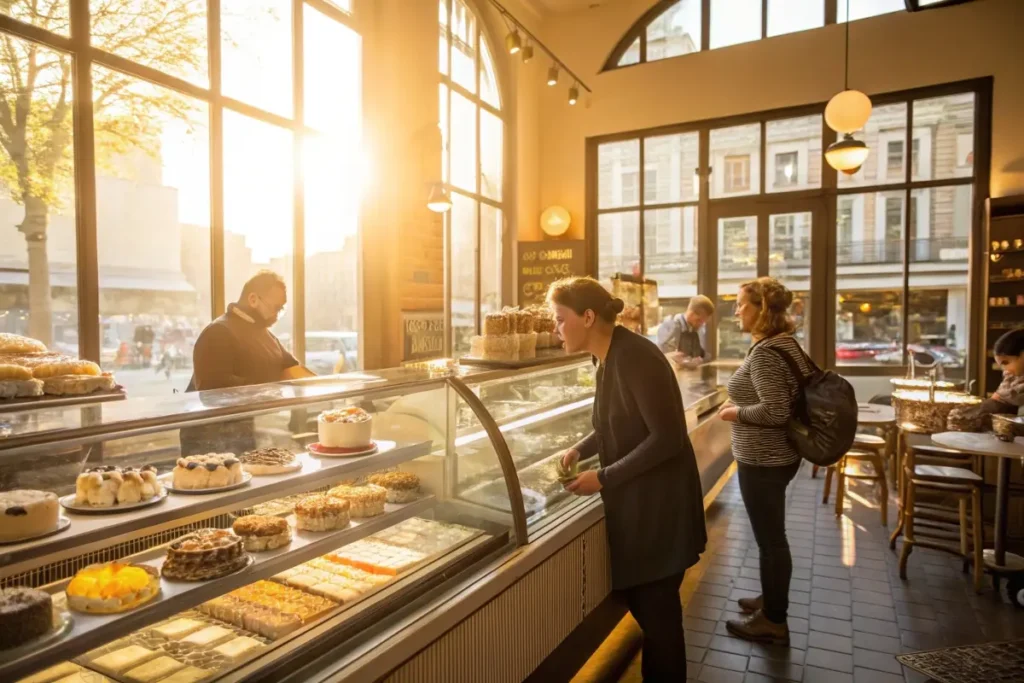Ever visited a bakery or café and wondered how they keep those beautifully frosted cakes looking fresh all day? For many, the answer lies in a cake dIsplay freezer—also spelled as “cake display freezer.” While the correct spelling might typically be “cake display freezer,” the essence remains the same. This specialized equipment seamlessly merges presentation with proper refrigeration, ensuring your pastries, cakes, and desserts stay pristine.
In this guide, we’ll explore the ins and outs of cake display freezer units, from their essential features and benefits to practical use cases, historical context, and a comprehensive FAQ. By the end, you’ll know how to choose, operate, and maintain the best commercial bakery fridge for your business or even home kitchen. And if you enjoy experimenting with sweet treats, check out our Japanese Dessert Recipes for new inspirations—perfect for displaying in your brand-new freezer.
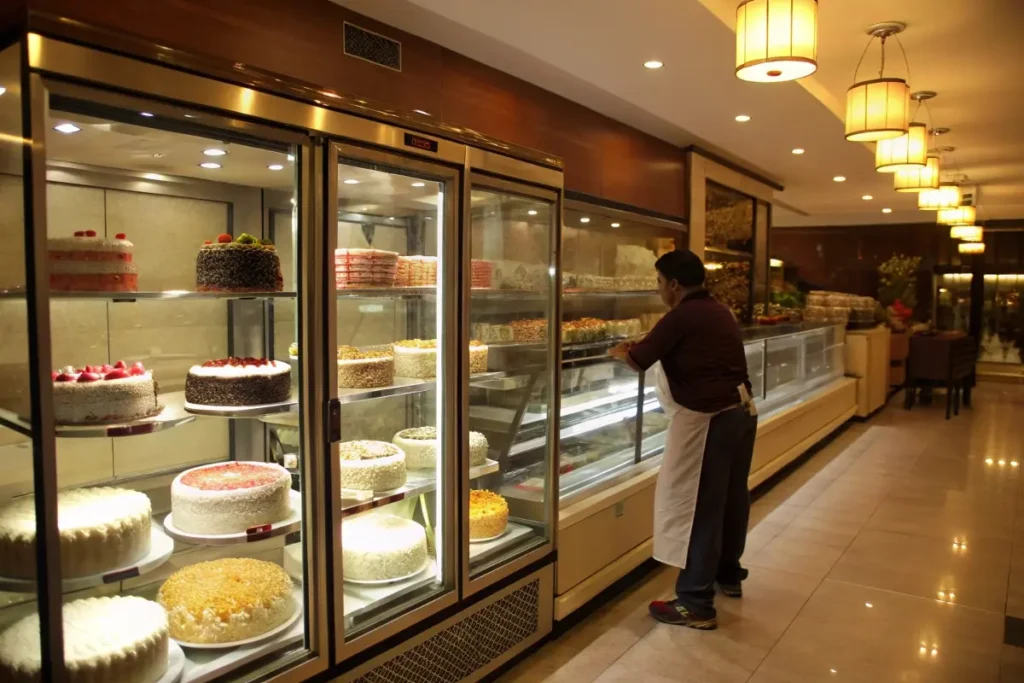
Table of Contents
1. Understanding the Cake Desplay Freezer
1.1 What Is a Cake Display Freezer?
A cake display freezer—commonly known as a dessert display fridge or cake display fridge—is a refrigeration unit designed to show off pastries, cakes, and desserts while keeping them at safe, chilly temperatures. Unlike regular refrigerators, these units often feature glass doors or panels for visibility and interior lighting to highlight the products. They may maintain slightly higher or lower humidity levels depending on the pastry type, ensuring minimal drying or wilting.
Key Attributes:
- Glass Enclosures: Typically made with tempered glass for durability and insulation.
- Adjustable Shelving: Lets you customize the layout, showcasing taller layer cakes or smaller pastries.
- Precise Temperature Control: Ensures everything from sponge cakes to mousse remains stable without spoiling.
This equipment is crucial not only in pastry fridge contexts but also for convenience stores, hotels, and cafes wanting to enhance sales through visual appeal.
1.2 Differentiating Display Freezers from Other Units
You might be familiar with a bakery display refrigerator or an open-air merchandiser. So what sets a cake display freezer apart?
- Freezer vs. Fridge: A freezer typically operates at sub-zero or near-frozen temperatures (e.g., 0°F to -10°F), perfect for ice-cream cakes or items needing extended shelf life. Meanwhile, a standard dessert display fridge might hold at slightly above freezing to accommodate cream-based pastries.
- Humidity and Airflow: Some advanced units manage internal moisture to prevent frosting from hardening or cracking.
- Aesthetics: Curved glass, LED lighting, and rotating cake stands often come standard, focusing on elevating presentation.
1.3 Why Invest in a Dedicated Cake Display?
- Sales Boost: Eye-catching displays entice impulse purchases. A vivid array of desserts behind crystal-clear glass can sway customers.
- Quality Maintenance: Whether you’re a bakery, cafe, or catering service, preserving taste and texture is paramount. The right unit extends product shelf life, cutting down on waste.
- Brand Image: Sleek, well-maintained equipment signals professionalism and care, reinforcing trust in your baked goods.
1.4 Ideal Venues
- Bakeries: From small local shops to large franchises, where cake display fridges let customers see every swirl of icing.
- Cafés and Coffee Shops: Combine coffee aroma with a tempting display of chilled desserts.
- Hotel Buffets: Highlight specialty cakes and pastries for guests.
- Convenience Stores: Quick-serve counters featuring grab-and-go slices or mini treats.
For specialized dessert ideas that can shine in these units, check out our Traditional Japanese Desserts Recipe for subtle sweets like matcha cakes, mochi, or fruit tarts that benefit from stable refrigeration.
1.5 Temperature Ranges
A typical cake display freezer might keep items between 35°F and 41°F (2°C-5°C) if it’s more a fridge than a sub-zero freezer. Actual freezers used for ice cream or deeply frozen pastries might maintain 0°F to -10°F. Owners should calibrate the temperature to the desserts’ needs—sensitive frostings might degrade if too cold, while certain cheesecakes require near-zero conditions for optimal consistency.
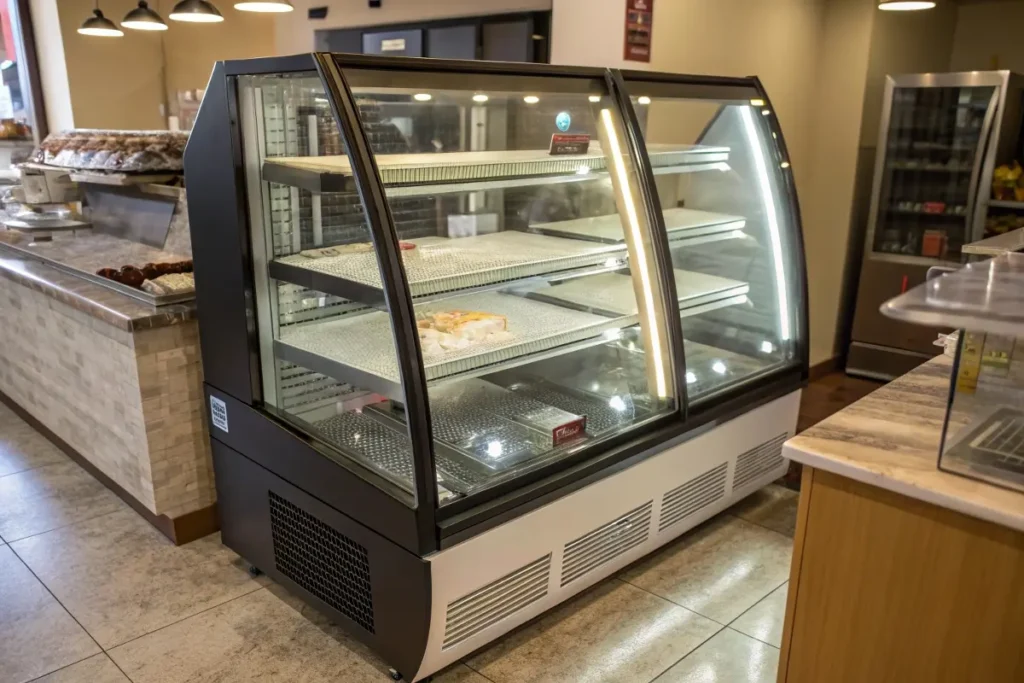
2. Main Features and Buying Considerations
2.1 Key Design Elements
- Glass Doors and Panels
- Tempered or double-pane glass reduces condensation and keeps external warmth at bay.
- Curved vs. straight glass choices impact how glare or reflections appear.
- Shelf Configuration
- Fixed vs. adjustable. Tiered shelves typically create a vertical, layered effect for showcasing multiple cakes simultaneously.
- Rotating shelves, especially in pastry fridge units, allow 360° viewing.
- Lighting
- LED lights are energy-efficient, produce minimal heat, and highlight cake details (frosting swirls, fruit toppings).
- Some units offer color-adjustable or dimmable lights.
- Door Style
- Swing doors or sliding doors. The latter can save space in tight corners or narrow aisles.
- Some commercial bakery fridge models include dual door functionality for easy restocking from the back.
2.2 Temperature Control and Refrigeration System
Beyond the aesthetics, a cake display freezer must maintain consistent temperatures:
- Compressor Type: Some rely on remote compressors placed outside the main area, reducing noise and heat near the display. Others have built-in compressors for easy mobility.
- Fan-Assisted Cooling: Ensures uniform airflow around each dessert, preventing hot/cold spots.
- Defrost Mechanism: Automatic defrost cycles reduce ice buildup, safeguarding the clarity of glass panels and preventing temperature swings.
2.3 Sizing and Capacity
From compact countertop models for small cafés to floor-standing behemoths in busy bakeries, sizing influences:
- Storage Volume: More shelves mean more displayed cakes, but also a bigger footprint.
- Energy Consumption: Larger units can raise utility bills. Balanced capacity is key—avoid overbuying.
- Space Constraints: Measure doorways, aisles, and customer flow to ensure the unit fits.
2.4 Energy Efficiency and Sustainability
With rising energy costs, efficient dessert display fridge solutions help manage overhead:
- Energy Star Ratings: Indicate compliance with certain efficiency standards.
- Insulation Quality: Adequate insulation retains chill, lowering compressor workload.
- LED Lighting: Minimizes extra heat, cuts electricity usage.
2.5 Maintenance Factors
- Cleaning Ease: Detachable shelves, removable drip trays, and simple door seal designs facilitate routine hygiene.
- Replacement Parts: Are brand-specific components easily available? Is local technical support accessible?
- Warranty: Many reputable manufacturers provide coverage for compressors or sealed systems over multiple years.
2.6 Additional Accessories
- Digital Thermostats: Provide exact temperature readouts. Alarms can alert if readings go out of range.
- Humidity Controls: In some top-tier units, adjustable humidity keeps items from drying out or collecting condensation.
- Caster Wheels: Move the bakery display refrigerator around for cleaning or rearranging.
When sifting through these features, consider synergy with your brand style. For instance, a sleek, stainless-steel finish might suit a modern café, while a wood-accented look complements rustic bakeries. For a broader sense of how equipment integrates with curated menus, explore our Japanese Chicken Fried Rice Recipe to see how a balanced front-of-house design can match your back-of-house culinary style.
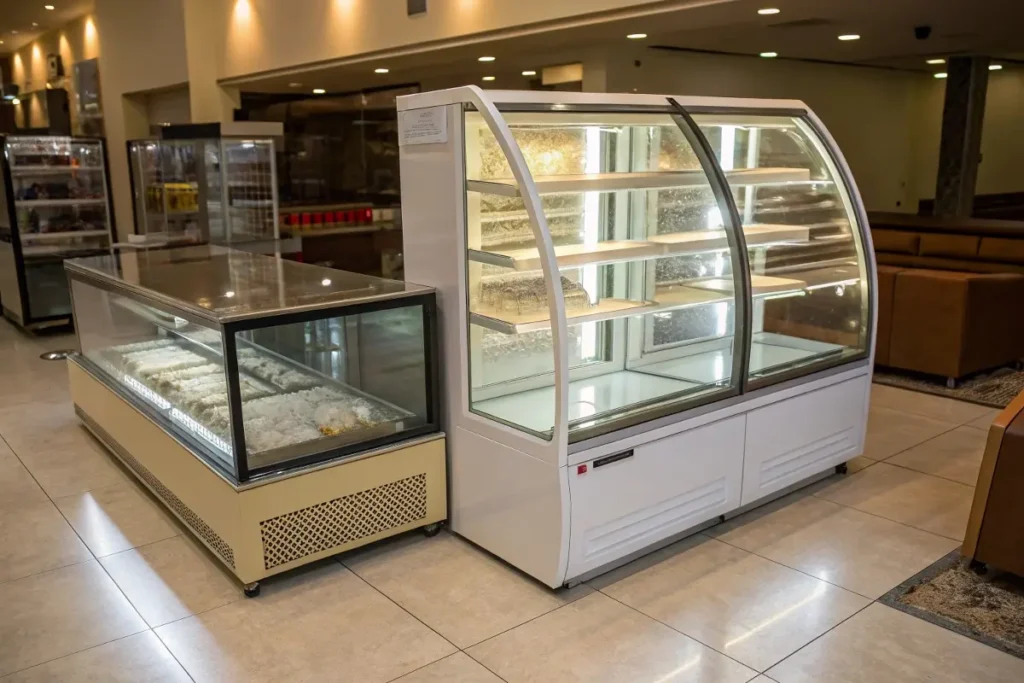
3. History and Context
3.1 Early Refrigeration of Baked Goods
Before electric refrigeration, bakers relied on ice blocks or natural cool cellars to preserve pastries. They recognized the value of cold storage in preventing spoilage, especially in warm climates. However, limited technology meant cakes were often displayed in open-air counters, risking dryness and bacterial growth.
3.2 Emergence of Glass Display Fridges
The industrial revolution paved the way for mechanical refrigeration. By the early 20th century, small diners and soda fountains began using glass display cases—often cooled by basic mechanical setups or large blocks of ice. Patrons could see the day’s pies, cakes, or pastries. As electricity and compressor tech evolved, dedicated dessert display fridge units became popular in corner bakeries, letting them extend product shelf life.
3.3 Rise of Modern Bakery Retail
Post-WWII economic booms in many countries spurred growth in commercial baking. Large chain bakeries, hotels, and supermarket expansions demanded consistent, visually appealing dessert presentation. Freed from location-based constraints, bakery display refrigerator designs advanced—introducing curved glass, improved lighting, and stable temperature controls. This era placed emphasis on marketing: the more enticing the display, the higher the dessert sales.
3.4 Contemporary Innovations
In the last few decades, technology soared. Energy efficiency soared too—modern units now incorporate:
- LED Lighting: Minimizes heat and highlight details.
- Precision Thermostats: Allows specific temperature and humidity calibration for delicate pastries like mousses or cheesecakes.
- Digital Monitoring: Remote alerts and data logging can track performance.
Simultaneously, consumer tastes shifted to premium pastries (think entremets, artisan cheesecakes, gluten-free or vegan lines). Their fragile components demanded reliable climate control. The cake display freezer stands at the heart of this ecosystem, guaranteeing gastronomic artistry remains visually pristine. For those keen on unique dessert concepts, see our Japanese Dessert Ideas—the right refrigeration can showcase mochi creations or matcha pastries with equal flair.
3.5 Global Adoption
From busy Hong Kong bakeries to chic Parisian patisseries, the principle remains universal: hooking customers visually. Cake display fridges or freezers preserve aesthetics in any climate. Modern materials—tempered glass, stainless steel, advanced coatings—ensure durability and easy cleaning. Vendors recognized that a single spoilage incident could tarnish brand reputation, so these advanced systems became essential. Looking ahead, we might see more “smart” freezers with remote access, self-cleaning cycles, or interactive LED screens.
Overall, the cake display freezer stands as a testament to how culinary presentation, engineering progress, and evolving consumer demands meld into a single, indispensable piece of commercial equipment.
4. Practical Examples/Use Cases
4.1 Small Café Showcase
Scenario: A neighborhood coffee shop wants to upsell pastries.
- Approach: Place a compact cake display fridge next to the cash register. The transparent front lures impulse buyers deciding on their latte.
- Result: Increases revenue through add-on purchases—mini cakes, muffins, or slices—drawn by appetizing visuals.
4.2 High-End Bakery
Scenario: A patisserie specializing in intricate entremets and custom wedding cakes.
- Approach: Install a large, curved-glass display freezer, complete with rotating shelves. The movement draws attention to delicate designs on each tier.
- Benefit: Premium ambiance fosters trust in quality, justifying higher price points. Extended freshness ensures fewer leftover discards.
4.3 Hotel Buffet or Catering Setup
Scenario: A hotel managing daily buffets, featuring desserts for breakfast, lunch, or dinner service.
- Approach: Use a well-lit pastry fridge at the buffet’s end, offering a variety of cakes and cold sweets. A staff member can restock from the rear door.
- Advantage: Maintaining ideal temperatures prevents rapid spoilage in extended buffet hours, upholding brand consistency for guests expecting premium experiences.
4.4 Home Enthusiast or Hobby Baker
Scenario: An avid baker wanting a dedicated space for personal creations.
- Approach: Invest in a smaller countertop dessert display fridge. Perfect for storing decorated cupcakes, layered chiffon cakes, or specialty tarts.
- Upshot: Impress family and guests with a visually enthralling, professional dessert display. Minimal risk of accidental smudging or temperature mishaps common in a standard fridge.
4.5 Seasonal Promotions
Scenario: A bakery sees spikes during holidays (Christmas, Easter, Valentine’s).
- Approach: The cake display freezer can highlight limited-edition items like heart-shaped cakes or pumpkin cheesecakes. Eye-level presentation and strategic signage boost seasonal sales.
- Outcome: Reduced spoilage risk, better brand recognition, and a hallmark of quality—since customers can see the artistry behind each creation.
For more tips on presenting desserts with cultural flair, check out our Japanese Cookies suggestions, easily displayed in smaller top-lit compartments. No matter your scale—home-based or commercial— the right freezer or fridge can revolutionize how you store and promote sweet treats.
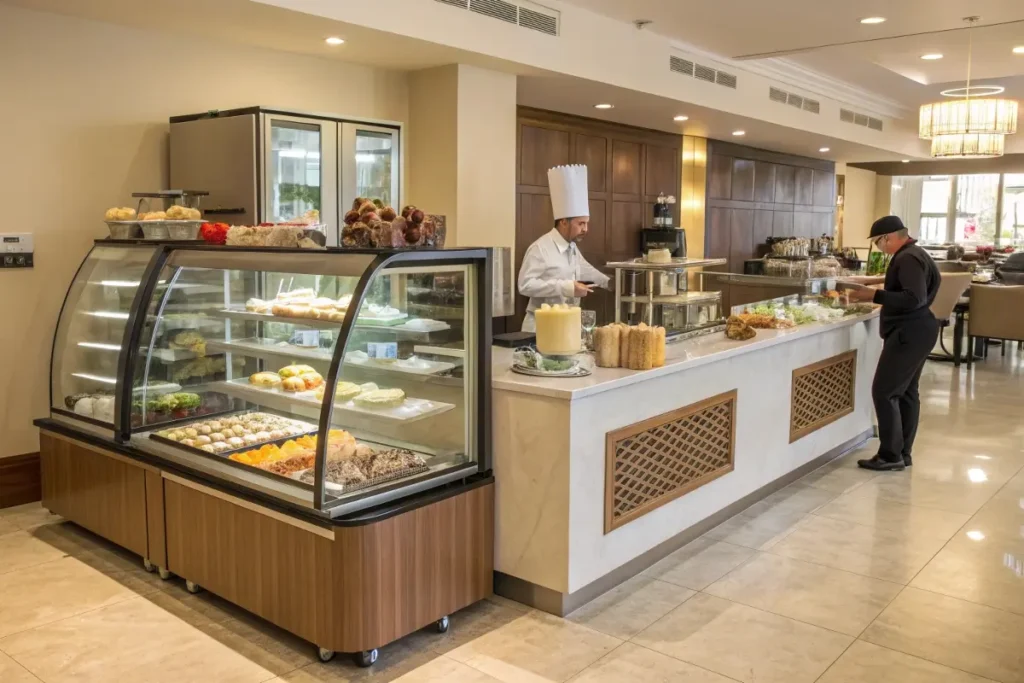
5. FAQs abour Cake Display Freezer
5.1 What is a beef banana shank?
While unrelated to a cake display freezer, you may see references to “banana shank.” That’s a cut of beef leg shaped similarly to a banana, requiring slow cooking. However, it has no direct relevance to commercial bakery appliances. For more on that topic, see our Beef Banana Shank Overview.
5.2 What is beef shank good for?
Beef shank is excellent for stews and braises, thanks to its tough yet flavorful muscle fibers. But it’s not typically displayed in a dessert fridge, so you won’t find it inside a cake display freezer.
5.3 Is shank a good cut of beef?
Yes—if you have time to slow-cook or braise it. Though again, it’s quite different from sweet pastries or cakes you’d preserve in a dessert display fridge.
5.4 What is the preferred cooking method for shank?
A low and slow braise. But for sweet treats, we typically use specialized bakery display refrigerator or pastry fridge units to hold the correct temperature.
5.5 Are cake display freezers the same as pastry fridges?
They overlap in function but can differ in temperature range. A freezer might operate at sub-zero for preserving items long term or for ice cream cakes, while a pastry fridge might hold slightly above freezing for cream tarts and fruit-based sweets.
5.6 What about storing multiple dessert types (e.g., cheesecakes vs. macarons) together?
Ensure you consider humidity and temperature differences. Macarons like dryness, while cheesecakes need consistent chills. A versatile dessert display fridge can handle them if you monitor or separate sections properly.
5.7 How do I maintain a commercial bakery fridge?
Regular cleaning of shelves and drip trays, consistent temperature checks, defrosting as needed, and verifying door seals. A monthly or quarterly deep-clean prevents buildup and odor.

Conclusion
A cake display freezer stands at the intersection of visual merchandising and reliable refrigeration—two essential factors for successful dessert sales or impressive home baking. From the glimmer of its glass panels to the consistent chill preserving delicate frostings, these specialized units prove invaluable in both commercial and personal kitchens. Whether you run a bustling bakery or simply love presenting artisanal cheesecakes to guests, you’ll benefit from stable temperature control, humidity management, and a crystal-clear vantage point for each mouthwatering confection.
Remember, picking the right cake display freezer involves balancing capacity, energy consumption, and aesthetics. Do you need rotating shelves? Will your café thrive with a curved-glass design for better angles? Are you storing ice-cream cakes requiring a sub-zero environment, or just standard pastries needing moderate coolness? By pondering these questions—and ensuring proper cleaning and maintenance—you secure an investment that pays off in extended freshness, reduced waste, and that “wow” factor crucial to modern dessert presentation.
Ready to level up your dessert game? Browse our Best Japanese Desserts for inventive treats that deserve a prime spot in your new display freezer. In the end, a well-chosen and well-maintained cake display freezer can serve as the heart of your bakery or the showstopping piece in your home cooking repertoire, ensuring sweet success for years to come.
